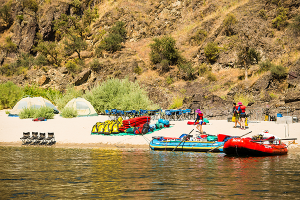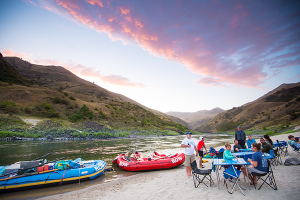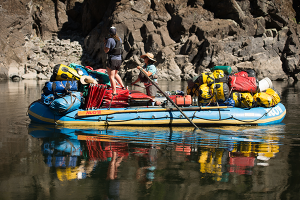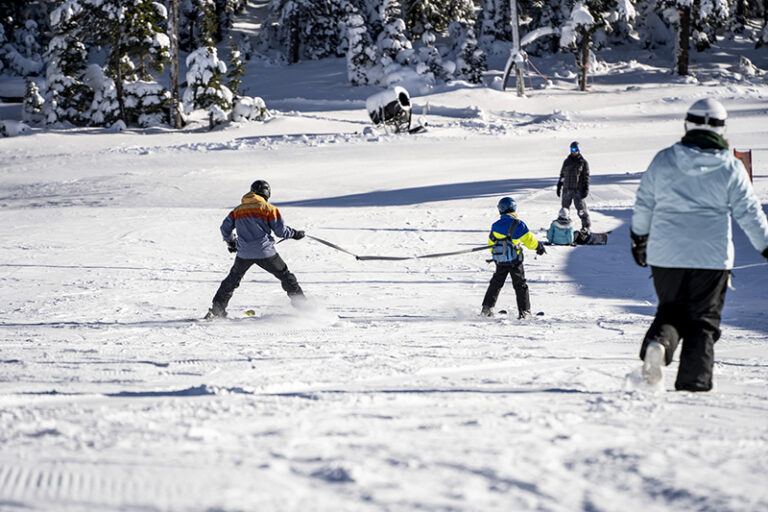Like many regions of the country, the Inland Northwest is home to wonderful outdoor pursuits, but it is fair to say that we live in the very best part of the United States for multi-day rafting adventures. We have more miles of undammed, free-flowing rivers with a decent gradient than any other part of the nation. The Salmon River in Idaho is the longest of these, and the John Day in Oregon is the second longest. But those are just the tip of the iceberg. Local boaters have a ‘bucket list’ of western rivers to choose from that can keep one occupied for decades. Here I cover three rivers, in increasing level of difficulty, that a new boater could, with further research, hope to tackle as they become more skilled.
If you are looking to float one of these rivers with a guide, little to no experience is required. On the other hand, to captain your own private trip, you should have experience successfully navigating a boat around rocks and other hazards and through a sequence of rapids, knowledge of river safety and rescue techniques, and experience camping in the backcountry. The beauty of a multi-day rafting trip is that it allows you to experience some of the most scenic places on earth from a unique perspective and with enough support gear that you can camp in relative luxury compared to a backpacking trip.

Trips of this nature use the same style rafts that you may have seen paddled before, with the difference that a metal frame is strapped to the top. This frame replaces the thwarts in the center of the raft to keep the boat structurally rigid, and also provides several bays in which to store needed camping essentials in coolers and dry boxes. It also comes with a tractor style chair and oarlocks so that the raft can be captained by a single rower instead of a team of paddlers. With the forward and aft compartments available for storing a large quantity of drybags, everything needed for a group of people to live outdoors in comfort for 3-7 days can easily be accommodated. Like most outdoor pursuits, the acquisition of this equipment represents a significant investment, but local universities rent out everything you need so that you can try your hand at it before making the larger investment. There are also numerous rafting outfitters in this region, and making an initial trip with professional guides is a great way to sample what this sport has to offer in a way that is both safe and informative for those wanting to get started. If your interest has been piqued, these three rivers offer a progression of trips from easy to more difficult.

The Grande Ronde River
The name is French for “big round” river, but the experience is quintessentially American. This river put-in, where you need to fill out a self-issue permit, is located in northeast Oregon’s Blue Mountains, a little over a four-hour drive from Spokane. The raft trip actually begins near Minam, Ore. on the Wallowa River which drains the Eagle Cap Wilderness and connects with the Grande Ronde just a few miles below the put-in. This mountain stream flows quickly through a canyon with open stands of yellow pine and open grass hillsides that constantly provide pastoral scenery on both sides. Shortly after the intersection of the two streams, all side roads come to an end, and the rest of your trip will be in a roadless portion of the Wallowa Whitman National Forest with the take out near the town of Troy, Ore. The relative remoteness means this river never fails to produce wildlife sightings. Eagles and osprey are common, and during our most recent trip we saw a bald eagle hauling a large fish up the bank on one day only to see another one attack a flock of geese that flushed on our approach the following day. You will certainly see deer and probably bighorn sheep. Once, we even saw a mountain goat right on the river bank.
There are ample campsites along the river that are first-come, first-served, and the only time you may have trouble finding one is during the busy Memorial Day weekend. This is a perfect river for beginners because the scenery is wonderful, the logistics are fairly simple, and the rapids are mostly mild. The rapids on this river are class II at normal flows, and the gradient of the river makes it easy to accomplish the 45-mile run in just 2-3 days during the season, which starts in May and can run through early July depending on river flows. The Grande Ronde River is where our sons learned to captain their own boats for the first time, and you could too.

The Lower Salmon River
This section of river begins a few miles downstream from the town of Riggins, billed as the whitewater capital of Idaho. Indeed, this is a great place to catch some really exciting rides through fun rapids on day trips. But if you are looking to extend the fun over a few more days, then start further downstream near the town of White Bird, Idaho, and float 74 miles over the course of 4-5 days and take out at Heller’s Bar near Asotin, Wash., at which point you will have been floating on the Snake River for roughly 22 miles from where the Salmon River joins the Snake in the lower reaches of Hell’s Canyon. This multi-day section requires a self-issue permit available at the Hammer Creek boat launch.
The Lower Salmon is larger than the Grande Ronde, and it drains such a significant area that it has enough water for rafting throughout the summer. This is a family favorite because the water is typically warm enough to make swimming a true pleasure, and there are huge white sand beaches for camping. This river is not in a designated wilderness, but there are so few access points that it may as well be. The canyon in this stretch is quite arid and there is a scarcity of trees, but the scenery is no less stunning because of it.

The rapids on this river are a noticeable step up from those on the Grande Ronde. There are numerous class III’s, two of which require careful maneuvering. There is one class IV on the river named Snow Hole because the large reversal created by the submerged boulder creates a frothing, churning mess that is as white as snow. If you enter this rapid correctly, the rapid is rather straightforward, but if you enter too far left or right you will quickly find yourself in a serious situation. This is not a river for beginners, but a boatman with developing Class IV skills would find this a good river a good test.
The Main Salmon River
The mighty Salmon River is the one that Lewis and Clark chose to bypass because it was considered un-runnable, but fortunately the inflatable boats of today are quite a bit more capable than what they fashioned from logs during their expedition. This is the same river as the Lower Salmon, only further upstream with a put-in near the town of North Fork, Idaho, and a take-out located about 30 miles upstream from Riggins. This trip, which requires boaters to put in for a lottery-based permit, represents 80 miles of Wild and Scenic River running through the largest designated wilderness in the lower 48 states, the Frank Church ‘River of No Return’ Wilderness. Running this river would be a logical next step in the progression after having completed the Lower Salmon, because the river is more remote and there are numerous Class IV rapids to navigate that are of greater complexity than the single one found on the lower section.

The Main Salmon starts at a high enough elevation to be enshrouded in evergreen forest, but over the course of 5-6 days, as you lose elevation, it transitions into the desert canyon climate familiar to those who have been to Riggins. I always enjoy witnessing this transition of habitats and catching glimpses of the different flora and fauna, just as much as I enjoy soaking in the natural hot spring at river’s edge part way through the trip. This river is also noteworthy for the extensive pioneer history at the various old homesteads, which are amazing testaments to the hardy people who first homesteaded this rugged region. A multi-day raft trip through the heart of this wilderness on one of the most iconic rivers of the West will be a memory you and your family or friends will never forget.
Each of these rivers has a different character and a different required skill level, so the motivated rafter should be able to find something that is a match. But be careful because once you start rafting you will likely find that it gets in your blood, and you will spend a lot of your spare moments dreaming of your time on the river.













